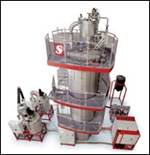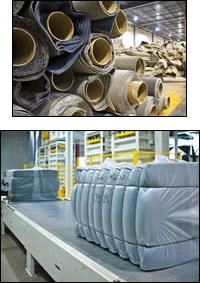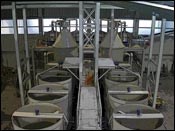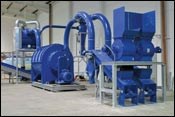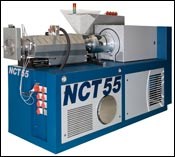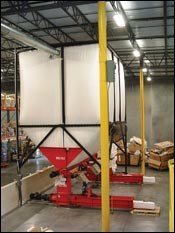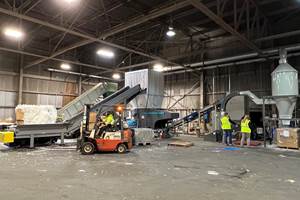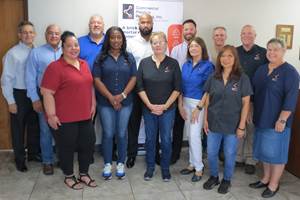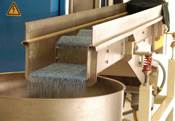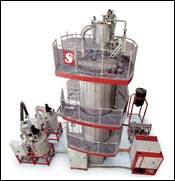Recycling Is Hot: Lots of New Plants Trying Out New Technologies
With virgin resin so expensive, there’s plenty of recycling action—from PET bottle-to-bottle plants to new projects aimed at agricultural film, carpets, and auto-shredder residue.
New recycling plants accounted for plenty of buzz at both the K 2007 show in Germany, last October and at the Plastics Recycling 2008 conference in Jacksonville, Fla., in February (sponsored by Resource Recycling magazine). Some of these new recycling operations will exploit established processes for squeaky-clean PET bottle-to-bottle reprocessing. Others will try out brand-new methods for recapturing some of the most challenging piles of plastic waste. Most of the new recycling equipment and processes presented at both meetings were either developed for these new plants or will be used by them.
The source of all this activity is not hard to discern. It comes down to two kinds of “Eco” logic. One is economical: Virgin resin prices are through the roof, driven by oil and gas prices and swelling demand from developing economies in China, India, and Latin America. The other “eco” is ecological, as corporations become more conscious of their environmental footprints and seek renewable resources.
BOTTLE-TO-BOTTLE ACTION
Major new bottle-to-bottle (“B2B”) PET recycling plants are being built in North America, including the two-phase expansion of United Resource Recovery Corp.’s Spartanburg, S.C., plant from demonstration scale to 40 million lb and ultimately to 110 million lb/yr. The first phase of this URRC expansion starts up this summer to supply crystallized chips (unpelletized and not solid-stated) to Coca-Cola. It’s the eighth and largest plant in the world to utilize URRC’s patented cleaning process, which removes contaminants by dissolving the surface layer off PET chips with a caustic solution.
PETstar, a division of MRF operator Avangard Innovative in Houston, will start up a bottle-grade PET recycling plant in Toluca, Mexico, this December. It will take in 60 million lb of post-consumer bottles and put out 50 million lb of clean PET. It has an Amut washing line from Italy and pelletizing and solid-stating equipment from Buhler AG in Switzerland.
Plastic Environmental Technology LLC, a new investor group in Ann Arbor, Mich., plans a 120-million-lb B2B PET plant in Modesto, Calif. The first of two phases (60 million lb/yr) is to open in early 2009, using an Amut washing line and Buhler pelletizing and solid-stating systems.
At least four more packaging companies are in the process of funding or setting up new B2B PET plants in North America, but they haven’t yet announced them or issued purchase orders on equipment. Amcor PET in Ann Arbor, Mich., may be the closest. It won’t wash the flake, but only pelletize and crystallize it.
At least two other new plants will only wash, not pelletize PET. E-Z Products in Cheraw, S.C., started up a new plant in January with capacity for about 36 million lb/yr of flake. Transit Plastics in Quebec City started up a plant in April rated at 10,000 lb/hr.
All that will help close the gap left when pioneer PET recycler Wellman Inc. closed its 190-million-lb Johnsonville, S.C., plant in late 2006. For the moment, there’s still less PET recycling capacity available now than there was last year, and the U.S. collects about twice as much post-consumer PET as it can wash and recycle.
There are even two new B2B plants for HDPE milk bottles in the U.K., part of the London-based WRAP (Waste and Resource Action Program). Amut’s first washing line for B2B HDPE started up early this year at Intercontinental Recycling in Lancashire, U.K. with capacity for 4400 lb/hr. Erema’s first Vacurema plant for HDPE started up in March at Green Star Waste Exchange Services in Teeside, U.K. Green Star built its own wash system in-house.
NEW RPET TECHNOLOGIES
Late last year, Phoenix Technologies LLC got a Letter of No Objection from the FDA for using PET from a new recycling process for direct food contact. The process pulverizes PET flake to about 300 microns, devolatilizes the powder under vacuum for 5 hr at 338 F, then compacts the powder into porous pellets using a patented additive (U.S. Pat. # 7262244), which maintains high I.V. Phoenix’s original PET process devolatilized finely ground (0.25 in.) PET flake and then pelletized it.
Amut SpA in Italy has built its largest friction washer ever, for up to 8800 lb/hr of PET bottle flake. Until now, its largest unit ran 6600 lb/hr. Water use is still only 0.45 liter/lb of plastic. Amut has built one unit, delivered last year to Freudenberg Politex in Colmar, France.
Amut also developed a very low-output (1100 lb/hr) modular PET recycling plant that fits into two 40-ft containers. Operating cost is 6¢ to 7¢/lb, the company says. It includes a wet grinder, float/sink separation tank for polyolefins, friction washer, rinser, second float/sink tank, mechanical dryer, deduster, metal detector, and bag filler for clean flake, all fully automated with PLC control.
New Earth Systems, St. George, Utah, is building its first full-scale commercial RPET flake plant, designed to process over 70 million lb/yr, starting this year in Canoga Park, Calif. In 2006 New Earth developed a small, containerized PET bottle recycling system for 2000 lb/hr of washed flake. It was integrated with a containerized water-treatment plant called T-Prep.
Erema in Austria has doubled the crystallizing dryer pretreatment for PET flake in its Vacurema process. The new Vacurema Prime process uses two discontinuous pretreaters, holding batches of flake under vacuum, instead of one continuous pretreater. Erema says the longer dwell time raises the I.V. higher than with the continuous treater in the basic Vacurema process. Flake from water bottles (0.72 I.V.) goes up 10%, while flake from soda bottles (0.80 I.V.) gains only 6%.
Erema also introduced two new downstream units for PET, an inline crystallizer and an acetaldehyde (AA) reducer. The first is a large insulated vibrating tray that crystallizes pellets using retained heat from pelletizing. The AA reducer reheats pellets after crystallizing to push AA level below 1 ppm. It was announced at the Recycling 2008 conference but isn’t on the market yet. The first unit will be installed this summer for testing.
Sorema div. of Previero N. Srl in Italy (represented here by Common Sense Solutions) introduced equipment and process modifications to its washing system two years ago. Called Super Clean, the enhanced system is designed to remove an organic impurity found on some washed PET flake, which has reportedly caused vapor problems in crystallizing dryers. It has been retrofitted on six existing wash lines.
A screw compactor from Runi A/S in Denmark (four regional U.S. reps) is typically used for densifying EPS packaging (see below) but is now also being used to crush and dewater filled water bottles at several bottling plants in the U.S. and to dewater washed film in Europe.
NEW TECH FOR TOUGH JOBS
At least four new recycling plants started up in the past three years to tackle heavily contaminated or mixed plastics. The recovered materials are used for proprietary in-house molded products, wood-plastic lumber, railroad ties, and commercial pellets. In addition, two new plants in Australia and the U.K. turn agricultural film and unwashed mixed plastics into diesel fuel.
RKO Industries in LaBelle, Fla., has a three-year-old recycling plant that cleans agricultural mulch film and drip-irrigation hose with up to 35% contamination from soil and plant matter. It’s believed to be the first U.S. plant recycling these materials. (Some other plants here and in Europe recycle greenhouse covers.)
RKO’s recycling line recovers about 7 million lb/yr of LDPE with patent-pending equipment designed and built by Crain Associates, part-owner of RKO. The system was introduced at Recycling 2008. RKO turns the recovered LDPE into railroad ties with technology acquired from RTI Recycle Technologies International in Oran, Utah.
Champion Polymer Recycling, Winchester, Ky., which supplies material to Infiltrator Systems for in-ground septic tanks, started a dry-process recycling plant for post-consumer PP carpet two-and-half years ago (see Learn More box). The process shreds carpet, dry cleans it on a shaker table to remove loose dirt, and then extrudes, filters, and pelletizes.
Another post-consumer carpet cleaning plant is starting up now at ReEntry, a new recycling unit of InterfaceFLOR in LaGrange, Ga. The new plant uses a proprietary, European-developed dry carpet separation and cleaning technology to which Interface bought the rights. Interface uses the recovered nylon 6 and 66 and PVC in its own carpet-tile product and sells the reclaimed PP and PET. The plant can process about 30 million lb/yr of carpet. Interface’s process won the “Emerging Technologies” award in March from the Society of Plastics Engineer’s GPEC conference in Orlando, Fla.
One large European auto dismantler has begun recovering plastics from auto shredder residue (ASR) and more are working on it, as the European Union set a 2012 deadline for 95% material recovery from end-of-life cars. Technische Behandlungssysteme GmbH (TBS) in Enns, Austria, started a 200-million-lb/yr recycling plant in 2006 to recover plastics from ASR. TBS uses altered-density separation technology from TLT Turbo Laminare Trenntechnik Kunststoff-Recycling AG in Germany, which showed the technology at K 2007.
The density separation cascade starts by stirring 15% ASR and 85% plastics from post-consumer electronics and appliances into a 1.1-g/cc fluid in a mixing tank to wet the flake and remove air bubbles. This slurry is pumped into TLT’s density separation tank, where rotors create laminar flow, separating a lighter PE/PP/PS/ABS fraction (with slight metal contamination) out the top and a heavier PS/ABS/PC/PVC (with heavier metal contamination) fraction out the bottom. The heavy fraction is landfilled.
Part of the light fraction is used in hose for TBS’s steel production. Part goes to another recycler, where it is further separated into a polyolefin mix, PS, and ABS. At each stage, flake and liquid are separated by screens, the liquid is sieved and reused, and the flake goes into a centrifuge dryer.
MBA Polymers announced a new joint venture with European Metal Recycling Ltd. in Warrington, U.K., to build a 130-million-lb/yr plant to recycle plastics from ASR using MBA’s proprietary process.
DRY CLEANING PROCESSES
Three companies recently introduced new or improved methods for “dry” cleaning plastic waste. Pla.to GmbH (formerly Systec) in Cologne, Germany, upgraded its dry cleaning process to clean wetter contaminated material, like muddy agricultural film or “wet” flake containing up to 15% moisture. Pla.to (newly represented by Extrusion Auxiliary Services) added a scraper to its screen to clean off dirt and force it into a discharge auger. To protect the rapidly turning paddles against damage from rocks and sand, Pla.to added retrofittable tool holders for wear plates coated with tungsten-nickel carbide. The ag.-film cleaning unit is now larger, capable of dry cleaning up to 2000 lb/hr of shredded film or 8000 lb/hr of rigid flake.
One of the first installations of Pla.to’s new wet ag.-film cleaner is at Cynar Recycling Ltd. in Dublin, Ireland. It reclaims mulch films, which are then pyrolized and made into diesel fuel.
M.A.S. Maschinen und Anlagenbau Schulz (M.A.S.) GmbH in Pucking, Austria, an 18-month-old company started by Helmuth Schulz, former owner of Erema, has a new approach to dry cleaning. It’s a combination centrifuge and dryer that heats a drum with an internal rotor to dry flake. Then intense air blowers remove the dirt as dust. The system comes in two sizes for 1100 and 2200 lb/hr. The first was installed at Reoplast in the Czech Republic. Since then M.A.S. has sold 10 more, including one at a U.S. plant of Bridon Cordage, a British maker of industrial twine.
Dry cleaning can also be used before wet washing to reduce water usage and water cleanup costs. B+B Anlagenbau GmbH in Germany has begun building a dry pre-cleaning unit to be used for its carousel-type, continuous-batch hot-wash system for PET flake.
No pre-cleaning is used in the recycling extrusion system Artec Maschinenbau GmbH of Austria supplied for a semi-works plant at P Fuel Pty Ltd. in Hawthorn, Victoria, Australia, to make diesel fuel and gasoline. The melt is pumped directly into the pyrolysis chamber. The pyrolysis process was developed by Royco Korea Institute of Energy Research in Korea and is built in China. It produces 45% automotive diesel, 35% gasoline, and 20% fuel gas that powers the pyrolysis plant.
SORTING & FILTERING
At K 2007, Buhler Sortex of the U.K. presented new bichromatic camera color sorting of plastics. Seeing two light wavelengths reportedly allows different colors of the same color density to be separated.
Anzai Manufacturing Co. in Japan (represented here by Metal Processing System) makes a belt-type light/dark separator to detect discoloration or contamination in pellets.
Mogensen GmbH in Germany exhibited at the K show for the first time its vision sorting technology, called Mikro-Sort. The technology itself is 13 years old. It uses hardware developed in cooperation with Commodas GmbH (recently acquired by TiTech) to scan a cascade of falling flakes. The system removes clearly identifiable off-colors like black specks or colored PET flakes from uncolored clear ones. Minimum detection size is 0.3 to 0.5 mm for dark contamination and 2 mm for light shades. A standard system consists of a vibratory feeder, camera, illumination, software, and air-ejection system—all in one housing. Capacity is over 8000 lb/hr.
TiTech AS in Norway (represented here by Lubo USA) introduced at K a near-infrared sorting system with twice the resolution of its original Polysort HR. The new Polysort UHR (ultra-high-resolution) has NIR sensors that detect 6 x 6 mm flake.
S+S Separation and Sorting Technology in Germany has enhanced metal separation by adding a station ahead of the usual metal detectors. The new station inserts three magnetic probes into a stream of falling flake to remove more small metal fragments earlier in the recycling process.
NEWS IN SCRAP RECLAIM
M.A.S. has built a patent-pending corotating conical twin-screw recycling extruder, which the firm says is the first of its type. Conical shafts accept higher torque and have larger intake zones with higher surface area for devolatilization than parallel corotating screws. It comes in three sizes for reclaiming 440 to 2640 lb/hr of PE.
For high throughputs of reclaim, Next Generation Recycling GmbH in Austria has expanded its X-Gran series with two new larger sizes. First introduced at NPE 2006, it now comes in four sizes with extruder diameters from 145 to 205 mm. Material drops from the shredder into a conveying screw that force-feeds the extruder.
At the other end of the size spectrum, Munchy International Ltd., a unit of Boston Matthews in the U.K., showed the first prototype of a low-throughput recycling shredder/extruder to pelletize scrap film rolls, bags, or purgings. The “Muncher” can be hand-fed beside a conveyor or automatically fed film from a reel. Scrap enters the shredder and then is auger-fed to the 25:1 or 30:1 L/D extruder. Munchers come in three sizes for 220 to 1100 lb/hr.
NEWS IN EPS RECYCLING
Bulky EPS foam packaging waste, collected from fisheries and retailers of appliance white goods and electronics, is typically compacted to reduce disposal cost. The latest news is that compacted EPS logs are now being sold for reuse. “Nearly 100% of our customers now sell their reclaimed EPS,” says Phil Plotts, co-owner of Foam Equipment & Consulting Co., which represents Heger GmbH in Germany. Plotts says there are 15 Heger screw compactors in the U.S.
Heger introduced its smallest screw compactor, model GZV-S-B 130, at K 2007 for processing 30 to 40 lb/hr of EPS into a 130-mm-square endless log. Density is increased 40:1. Even newer is automatic density control up to 20 pcf. A T-bar applies pressure to EPS going into the compactor. Pressure is automatically adjusted according to the speed at which the log is produced. Heger also claims to offer the largest pre-crusher on the market. Its new Model 1800 has an 1800-mm-wide opening.
At K 2007, Runi of Denmark showed a new screw compactor configuration with three times higher throughput. It combines a large bag silo for shredded EPS with up to three compacting extruders instead of one. The first such high-output system was installed last year at a large furniture distributor in Lakeland, Fla.
Two other companies showed screwless compactors that compress EPS without heat in a manner similar to a baler. Mil-Tek, a Danish company with international franchises (including one in Los Angeles), showed a compactor that uses compressed air and electricity to produce an endless block of EPS with 40:1 densification at 175 lb/hr.
Bright Technologies Div. of Sebright Products announced its screwless EPS compactor at Recycling 2008. It uses hydraulic pressure to compress shredded EPS into a solid block of 20 pcf density in 1.5 min. The compactor is used primarily by large EPS molders to compact production scrap.
Related Content
How to Optimize Color Evaluation of Recycled Plastics
The right color measurement instrument and good working methods will minimize variability in color evaluation of PCR.
Read MorePurpose-Built System Enhances Capacity and Flexibility for Recycler
A Boston recycler invested in a turnkey shredding, granulation and elutriation system to expand its plastics reclaim business.
Read MoreProcessing Megatrends Drive New Product Developments at NPE2024
It’s all about sustainability and the circular economy, and it will be on display in Orlando across all the major processes. But there will be plenty to see in automation, AI and machine learning as well.
Read MoreInside the Florida Recycler Taking on NPE’s 100% Scrap Reuse Goal
Hundreds of tons of demonstration products will be created this week. Commercial Plastics Recycling is striving to recycle ALL of it.
Read MoreRead Next
Bottle-to-Bottle PET Recycling Uses Silicone Modifier
A new low-cost approach restores the properties of recycled PET bottle flake to produce new food-grade preforms and pellets.
Read MoreRecyclers Now Targeting Higher-Value Engineered Resins
Recycling news from the Society of Plastics Engineers’ Global Plastics Environmental Conference (GPEC) in Orlando, Fla., in March focused on PET, nylon, and waste plastics in electronics—in other words, mainly on higher value engineered resins rather than commodities.Carpet recycling claimed two of the show’s big environmental awards.
Read MoreClean and Upgrade Recycled PET
Two recently developed technologies are said to make high-quality PET recycling more economical.
Read More


